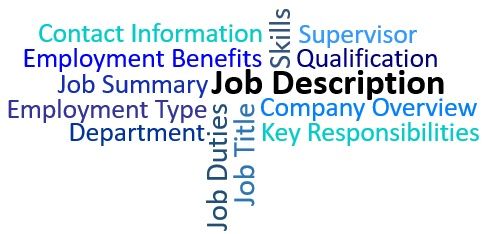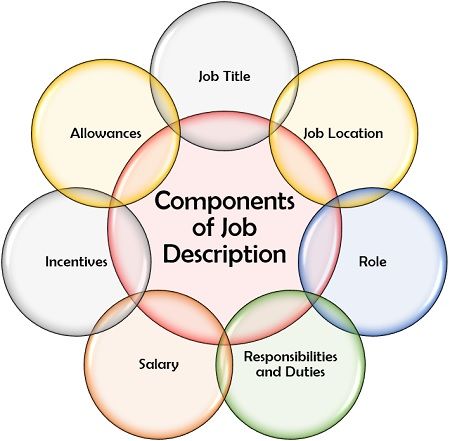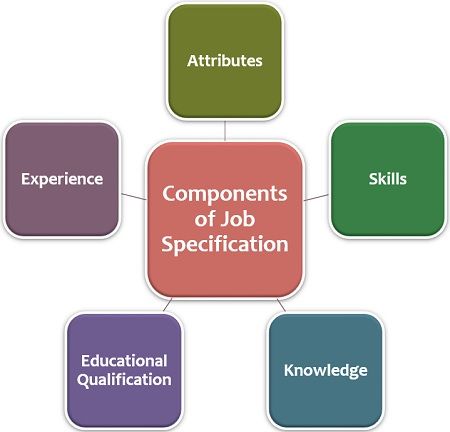The critical difference between job description and job specification is that; former is the summary of all the task, role and responsibilities specifying what the company is offering to the candidate. Whereas, the latter is an overview of all the attributes, experience and qualification which the company is looking for in a candidate to pursue the job.
Job description and job specification are the two essential components of job analysis.
Job analysis refers to the identification of the vacant job position and description of the task, duties, role, responsibilities and job title along with related requirements. It includes skills, qualification, knowledge and experience a person must possess to fill up that position.
Content: Difference Between Job Description and Job Specification
- Difference and Comparison
- Example
- What is Job Description?
- What is Job Specification?
- Advantages
- Disadvantages
- Summary
Difference and Comparison
| Basis | Job Description | Job Specification |
|---|---|---|
| Meaning | Job description is the written document in which all the information regarding a particular job including role, responsibilities and duties is summarized in a systematic manner. | Job specification is the set of specific qualities, knowledge and experience, a person must possess to perform a particular job. |
| Origin | Originates from Job Analysis | Based on Job Description |
| Elements | Consist of job title, job location, role, responsibilities, duties, salary, incentives and allowances | Involves personal attributes, skills, knowledge, educational qualification and experience |
| Objective | Describes the job profile | Specifies the eligibility criteria |
| What is it? | What the company is offering to the candidate. | What the company is demanding from the candidate. |
| Application by Human Resource Manager | Used to give the sufficient and relevant information of the job | Used to match the right attributes with the job so described |
Example
Let us assume that ABC Ltd. is looking for a sales executive. It has posted the job description and job specification regarding the post, on a job portal. It looked something like this:
Job Description – Sales Executive
About Us:
ABC Ltd. Is a well-renowned marketing and advertising company which has its branches spread all over the country with an approx of 500 employees working for it.
The company is into B2B sales where its clients are usually big business firms and some of which are corporate leaders.
Job Title: Sales Executive
Role:
We are looking for aspirant sales executives for the company. It is an office job where the candidate has to make outbound calls to convert prospective customers into clients. However, the candidate may need to travel to different cities at times.
We are looking for someone who has excellent communication skills and convincing power.
Duties and Responsibilities:
- Make outbound calls.
- Create new clients.
- Achieve sales targets.
- Handle direct customer enquiries.
- Prepare sales report.
- Explore and grab new business opportunities.
- Keep sales record on CRM software.
Job Specification – Sales Executive
Educational Qualification: Any graduate/MBA in Marketing or Sales is preferred
Personality, Skills and Competencies:
- Excellent communication skills
- Positive attitude
- Ability to work under pressure
- Negotiation skills
- Customer handling ability
- Takes initiative
- Capable of working for long hours
Experience: 0-1 years of experience in a similar job profile is preferred.
What is Job Description?
A job description is the detailed job information in a written format stating the role, responsibilities, duties, job title, job location, etc.
It is usually prepared by the human resource manager to invite applications from the prospective candidates to fill up the vacant job position.
Components: A job description consist of all the relevant information about a particular position or post in a company. It includes the following:
- Job Title is the name of the post vacant
- Job Location is the branch of the company where the candidate will be posted after selection.
- Role refers to the arena of work and how the responsibilities are to be fulfilled, defined by the company.
- Responsibilities and Duties is a list of various job-related activities which the candidate is supposed to perform and take account of his actions.
- Salary is the pay scale which the company is ready to offer for that particular job. It may or may not be negotiable.
- Incentives refer to commission and remuneration associated with the targets achieved.
- Allowances are the other benefits and expenses which the company pays on behalf of the candidate.
What is Job Specification?
A job specification is the written declaration of the attributes, skills, knowledge, educational qualification and experience which a person must possess to perform a particular job.
After preparing a job description, the manager analyzes the necessary abilities and attributes needed for accomplishing the task and thus drafts a job specification.
Components: Job specification emphasizes human qualities essential for a job. It involves the following elements:
- Educational Qualification defines the specific requirement regarding academic knowledge of a person. It includes his school education, graduate, post-graduation and other such qualifications of which he holds degree or mark sheet.
- Skills Required refers to the particular set of special abilities which are essential for the proper execution of the given tasks. The company may or may not ask for the certificate of training in such skills from the candidates.
- Experience is the information of all the past and present employment or association of the candidate, including the name of the company, post, duration, salary package, job profile, etc.
Advantages of Job Description for the Company
Job description holds the following benefits for the organization and the human resource department:
- Job description simplifies the work of the human resource department, synchronizing the recruitment and selection process.
- It also provides a base for framing the job specification.
- Because of a job description, it becomes easy for the companies to search for suitable candidates.
Advantages of Job Description for the Candidates
It is essential for the prospective candidates who are looking forward to associating with the company in the following ways:
- Job description clarifies what the company is and can offer to the candidates.
- It helps the candidate to become somewhat familiar with the workplace environment at a glance.
- It gives out a systematic overview of the vacant position and also specifies what the company wants from its employees.
Advantages of Job Specification
A job specification is the foundation of the recruitment process since it defines criteria for the selection of candidates. Let us understand the various benefits it has:
- Job specification saves time while the screening of the resumes of the prospective candidates by scrutinizing those who fulfil the eligibility criteria the most.
- It acts as a benchmark by the human resource manager for the training and orientation of the employees.
- It provides an overview of all the relevant requirements of a particular job to the prospective candidates.
- Job specification also helps candidates to find a suitable job by fitting in their skills and qualification in the mentioned job profile and eligibility criteria.
- It paves the way for performance analysis and appraisal of the candidates.
Disadvantages of Job Description
A job description has some limitation too. These are as follows:
- A job description is not constant and changes with time and growth of the company.
- It only outlines the positive aspects of a job, ignoring the obstacles and negative points.
Disadvantages of Job Specification
As we know, job specification arises from the job description; it also has some related problems. Let us have a look at those limitations:
- Change in technology impacts the requirement of the company, i.e. changing of skills, qualification, experience, knowledge needed to execute the roles and responsibilities properly.
- A job specification is a lengthy process and requires complete knowledge of the job position.
Summary
Job description and job specification both hold their importance in human resource management. But as we have already seen in the above comparative chart, they are very different from each other.
Let us now summarize the above differences as follows:
- The job description defines role, responsibilities and duties to be performed on a job position. Whereas, job specification is a particular set of skills or attributes required in a candidate to perform that job.
- The need for preparing a job description arises when the job analysis is done. However, job specification is made by the details of a job description.
- The essential components of the job description are a job title, job location, role, responsibilities, duties, salary, incentives and allowances. On the contrary, job specification includes personal attributes, skills, knowledge, educational qualification and experience.
- The job description is the description of the job profile, whereas job specification is the specification of eligibility criteria for that job profile.
- In other words, we can say that job description is the reflection of what the company is planning to offer to the candidate. But, job specification emphasizes the company’s demands and requirements from the suitable candidate.
- For a human resource manager, a job description is a tool for providing the necessary information about a job position. However, job specification is essential for matching the candidate’s attributes with that job position.
During the process of recruitment, job description and job specification hold equal importance. However, from the differences mentioned above, it is evident that both are way more different from each other.
Nur Anizah Aziz says
hi,
Thanks you for your sharing about JD and JS. Its very informative for us as a researcher. Can you share your citation for this article as our reference.
Thanks a lot for your cooperation.
Priya C says
“Job Description Vs Job Specification ” by Priya C.
theinvestorsbook.com 6 Aug 2019
Michael Dokup says
thank you so much.
much appreciated,
you’ve explained in very simple terms for those
of us where English is our second language.
thank you,
Michael
SWETHA KALLAGANAD says
Beautiful explanation.
One stop to the query.
Thank you.
Dr.Shanthi says
Very informative and useful.very precisely, clearly explained J.D. & J.S. I will use this for my teaching.Thank you madam.
Mohit Lahri says
Thanks a lot for this fabulous information